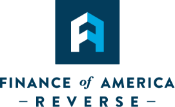With rates still low, you may be considering a refinance to lower your mortgage payments or generate needed cash. But did you know that refinancing to a reverse mortgage rather than a traditional mortgage might be a better option?
Let’s find out more about each option. Home refinancing is a forward loan, and reverse mortgage loans are home equity conversion mortgages. There are several different ways to receive payments based on your home’s equity. However, refinancing and reverse mortgages are two of the most popular methods.
What’s the difference?
According to the U.S. Department of Housing and Urban Development (HUD), a reverse mortgage is a particular type of home loan that lets a homeowner convert a portion of the equity in his or her home into cash. A home loan refinance is replacing the homeowner’s current mortgage with a new one for reasons like getting cash back on the equity, debt consolidation, payment of medical bills, and many other reasons.
| Conventional Refinancing | Reverse Mortgage |
|
|
|
|
|
|
|
|
|
|
While a reverse mortgage and a home loan refinance are similar in that both can entail cashing out on home equity, there are several key differences. For one thing, home refinancing and 2nd mortgages require you to have a reasonably low debt to income ratio. This, combined with a calculation of how much equity you have in your home and consideration of your credit scores, will determine whether or not you qualify and how much you can borrow. However, with a reverse mortgage, there are no income requirements. It’s available to you regardless of your current income.*
The amount you can borrow depends on your age, the current interest rate, and the appraised value of your home or FHA’s mortgage limits for your area.
Another key difference is that with mortgage refinancing and equity loans, you must repay the loan. With a reverse mortgage, you don’t make payments because the loan is not due as long as you live in the home as your primary residence. You have to continue paying your real estate taxes (property taxes) and your other bills, like your utility bills.
The only time you have to repay the reverse mortgage home is when you sell your home or no longer use it for your primary residence. At that point, you or your estate will have to repay the reverse mortgage loan. If there is any equity left in the house after the reverse mortgage is paid, it will go to you or your heirs. However, none of your other assets are affected to pay off the debt if your home loses value over time – this is considered a non-recourse loan. The debt is never passed along to the estate or your heirs, either. Let’s look at a case study to the long-term cash-flow differences with refinancing vs. getting a reverse mortgage.
Retirement Strategy Study
Joyce and Jim are recently retired, and their monthly cash flow is tighter than anticipated. They would like to pay off some of their debts to reduce their overall monthly expenses. They have limited savings and no retirement accounts or assets.
Home Value: $385,000 | Mortgage Balance: $95,000 ($1,100) Client Age: 68 | Other Debts: Credit Cards ($10,000), Car Loan ($5,000) Total Debt Payments: $1,750/month | Income: $2,900/month
Cash flow Savings: Monthly: $1,750 / Year 1: $21,000 / Year 5: $105,000
With reverse mortgage proceeds, pay off existing mortgage and all other debts using cash at closing. Their overall monthly cashflow is immediately increased by eliminating the monthly mortgage and other debt payments.
|
It should be noted that this example is for educational purposes only. With any reverse mortgage, the borrower must meet all loan obligations, including living on the property a principal residence and paying property charges, including property taxes, fees, and hazard insurance. Also, the borrower must maintain the home. If the homeowner does not meet these loan obligations, the loan will need to be repaid.
Reverse mortgages, with their built-in consumer safeguards and flexible options for accessing equity, are transforming the way people approach retirement. With any financial decision, it is essential to consider your options carefully. The right financial advisor can guide you to a great decision that works.
*The borrower must complete a financial assessment.
**The borrower must meet all loan obligations, including living in the property as the principal residence and paying property charges, including property taxes, fees, hazard insurance. The borrower must maintain the home. If the homeowner does not meet these loan obligations, then the loan will need to be repaid.
***The borrower must maintain homeowners’ insurance, maintain taxes, and maintain the property.
DISCLOSURES:
Oregon Only:·When the loan is due and payable, some or all of the equity in the property that is the subject of the reverse mortgage no longer belongs to borrowers, who may need to sell the home or otherwise repay the loan with interest from other proceeds. FAR may charge an origination fee, mortgage insurance premium, closing costs and servicing fees (added to the balance of the loan).·The balance of the loan grows over time and FAR charges interest on the balance.· Borrowers are responsible for paying property taxes, homeowner’s insurance, maintenance, and related taxes (which may be substantial). We do not establish an escrow account for disbursements of these payments. A set-aside account can be set up to pay taxes and insurance and may be required in some cases. Borrowers must occupy home as their primary residence and pay for ongoing maintenance; otherwise the loan becomes due and payable. The loan also becomes due and payable (and the property may be subject to a tax lien, other encumbrance, or foreclosure) when the last borrower, or eligible non-borrowing surviving spouse, dies, sells the home, permanently moves out, defaults on taxes, insurance payments, or maintenance, or does not otherwise comply with the loan terms. Interest is not tax-deductible until the loan is partially or fully repaid.
©2020 Finance of America Reverse LLC is licensed in 50 states and D.C. | Equal Housing Opportunity | NMLS ID # 2285 | www.nmls.consumeraccess.org | 8023 East 63rd Place, Suite 700 | Tulsa, OK 74133 Not all products and options are available in all states | Terms subject to change without notice | AZ Mortgage Banker License #0921300 | Licensed by the Department of Business Oversight under the California Residential Mortgage Lending Act | Georgia Residential Mortgage Licensee | Illinois Residential Mortgage Licensee | Kansas Licensed Mortgage Company | MA Lender/Broker #MC2855 | Licensed by the Mississippi Department of Banking and Consumer Finance | Licensed by the New Hampshire Banking Department | Licensed by the N.J. Department of Banking and Insurance | Licensed Mortgage Banker — NYS Banking Department where Finance of America Reverse is known as FAReverse LLC in lieu of true name Finance of America Reverse LLC | Rhode Island Licensed Lender | HUD HECMS REQUIRE PAYMENT OF INITIAL AND PERIODIC MORTGAGE INSURANCE PREMIUM.
This article is intended for general informational and educational purposes only, and should not be construed as financial or tax advice. For more information about whether a reverse mortgage may be right for you, you should consult an independent financial advisor. For tax advice, please consult a tax professional.















I WANT TO KEEP UP TO DATE ON RETIREMENT TRENDS
Follow Us.